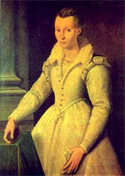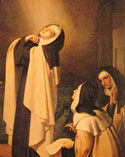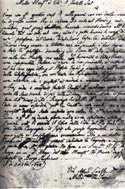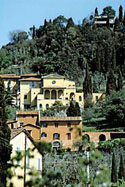| The Life of St. Mary Magdalene de' Pazzi | ||
| Biographical Sketch | ||
 |
Born in 1566, Catherine de' Pazzi was destined to live during one of the
more difficult periods in the history of the Catholic Church and to become
one of the Order's and indeed the Church's most exalted mystics. Even as a
girl she was attracted to prayer, solitude, and penance. She had a deep
devotion for the Eucharist, receiving his first Communion at the age of
ten and shortly thereafter making a vow of virginity. In the family, Catherine was called Lucrezia out of respect for her paternal grandmother, Lucrezia Mannucci. But this was never really accepted by Catherine herself because of her love for Catherine of Siena who had lived two centuries earlier but whose life would have a deep impact upon de'Pazzi's.
|
|
 |
Born into a
noble Florentine family, Catherine received religious training from the
Jesuits. At the age of nine she was taught how to meditate, using a
recently published work explaining how one should meditate on the Passion
of Christ. Year later, this book was one of the items she brought with her
to Carmel. In 1583 Catherine was received as a novice in the enclosed Carmelite monastery of St. Mary of the Angels in Florence, Italy in 1583. She took the name Maria Magdalen. Because of illness, a fever accompanied by violent coughing that appeared to put her life in jeopardy, her first profession was anticipated. The Florentine monastery was frequently a gathering place for women of the court of Florence-- among them the future wife of Henry IV of France. Others more familiar with the lives of the religious leaders and members of the religious orders came calling, giving the saint the opportunity to become very familiar with the shortcomings of life in the Church. |
|
 |
Mary Magdalen's
sudden cure after her profession was followed by a state of ecstasy which
lasted forty days. Every morning after Mass, the young sister fell into an
ecstasy lasting two hours. At other times she experienced "excesses of
love." These ecstasies continued into the year 1585 often with such frequency that one other nun recorded "We can hardly find a free moment to speak to her, as she is constantly in a state of elevation of mind." Often these ecstasies involved colloquy. This time of spiritual consolation was followed by "the lion's den," a five-year period of "the greatest trial and affliction of spirit," beginning on Trinity Sunday, June 16, 1585. Gone was the sense of joy in God's presence. Her whole life seemed a mistake. She was severely tested against chastity. She underwent doubts about her vocation. Ecstasies were still experienced but they brought little comfort. She was tempted to run away from the monastery and commit suicide.
|
|
 |
The Church in the second half of the 1500's was struggling with its
interior difficulties as well as forces for change from the outside. The
Council of Trent had concluded in 1563, three years before Catherine de'
Pazzi was born. But the people and the hierarchy were still struggling to
implement the doctrinal statements and the reforms called for by the
Council years after Pope Paul IV confirmed all the Council's decrees on
January 26, 1564. Within the lengthy list of the Council's reforms was
that of religious life. The ecstasies of Sr. Mary Magdalen continued. In some, Jesus was urging her to reform the Church and her community. Together with the spread of the Gospel and an anxiety for the salvation of souls, this theme of the renewal of the Church and of religious life in the Church, became her major focuses. Mary Magdalen wrote a dozen letters which exist today, dating from July 25 to September 4, 1586, dictated by the saint while in ecstasy. Each of the 12 letters deals with the same topic: the urgent need for the renewal of the Church and in particular of religious.
|
|
 |
On the feast of
Pentecost, June 10, 1590, in a vision of the saints, Mary Magdelen was
freed from "the lion's den." Her ecstasies began occurring less frequently
but they only ceased with her last illness, beginning in 1604. But it is not because of her experience of ecstasy that Mary Magdalen was canonized but for perfection of love, manifested in fidelity to daily duty and sincere dedication to the needs of others. She rose early to light the fire in the kitchen or laundry and spent hours cooking and washing. She was devoted to the aged and infirm; she would have dearly love to be the nurse of the monastery. From 1595 to 1598 she was in charge of the junior professed. In 1598 she was elected novice mistress; in 1604, sub-prioress. It was in this year that Mary Magdalen
took to her bed. For some time she had been suffering hemorrhages, fever,
and coughing spells. Violent headaches were part of her suffering to the
point she could not eat. "To suffer, not to die" is the motto attributed
to her and the perfect expression of her spirit.
|
|
 |
Following her death at age 41, various
miracles occurred when people visited her grave. One year after her burial, permission was given to bring it back into the cloister, into the room where she died. Her body was found to be intact. The process for beatification began in August 1611. She was beatified by Pope Urban VIII in 1626 and canonized by Pope Clement IX on April 28, 1669. The Carmelite monastery has moved a couple of times from the monastery where the Saint lived and died. However, her incorrupt body remains with the community. |
|
| from: The Carmelites: The Post Tridentine Period 1550-1600 (vol III) by Joachim Smet, O. Carm. La rinnovazione della Chiesa Lettere dettate in estasi Cittą Nuova - Edizioni O.C.D. © 1986 ISBN 88-311-4804-4 |
||